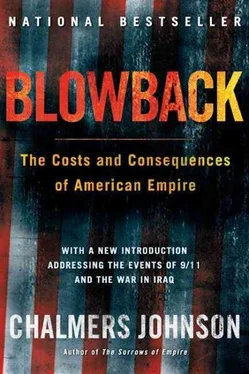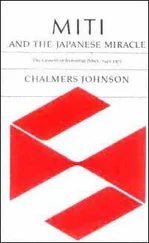Chalmers Johnson - Blowback, Second Edition - The Costs and Consequences of American Empire
Здесь есть возможность читать онлайн «Chalmers Johnson - Blowback, Second Edition - The Costs and Consequences of American Empire» весь текст электронной книги совершенно бесплатно (целиком полную версию без сокращений). В некоторых случаях можно слушать аудио, скачать через торрент в формате fb2 и присутствует краткое содержание. Год выпуска: 0101, ISBN: 0101, Издательство: Macmillan, Жанр: Старинная литература, на английском языке. Описание произведения, (предисловие) а так же отзывы посетителей доступны на портале библиотеки ЛибКат.
- Название:Blowback, Second Edition: The Costs and Consequences of American Empire
- Автор:
- Издательство:Macmillan
- Жанр:
- Год:0101
- ISBN:9780805075595
- Рейтинг книги:5 / 5. Голосов: 1
-
Избранное:Добавить в избранное
- Отзывы:
-
Ваша оценка:
- 100
- 1
- 2
- 3
- 4
- 5
Blowback, Second Edition: The Costs and Consequences of American Empire: краткое содержание, описание и аннотация
Предлагаем к чтению аннотацию, описание, краткое содержание или предисловие (зависит от того, что написал сам автор книги «Blowback, Second Edition: The Costs and Consequences of American Empire»). Если вы не нашли необходимую информацию о книге — напишите в комментариях, мы постараемся отыскать её.
Blowback, Second Edition: The Costs and Consequences of American Empire — читать онлайн бесплатно полную книгу (весь текст) целиком
Ниже представлен текст книги, разбитый по страницам. Система сохранения места последней прочитанной страницы, позволяет с удобством читать онлайн бесплатно книгу «Blowback, Second Edition: The Costs and Consequences of American Empire», без необходимости каждый раз заново искать на чём Вы остановились. Поставьте закладку, и сможете в любой момент перейти на страницу, на которой закончили чтение.
Интервал:
Закладка:
Needless to say, the American press has barely reported these developments; and the Pentagon certainly never uses the term “sympathy budget,” preferring instead the euphemism “host nation support.” According to a 1998 Department of Defense report on allied nations’ “contributions to the common defense,” Japan’s host nation support is the most generous of all. It supplied 78 percent of the costs of the 42,962 U.S. troops on its soil, while Germany paid only 27 percent of the costs of the 48,878 U.S. troops based there. Of the 1997 omoiyari yosan , a bit more than half, or ¥146.2 billion, went to pay the salaries of Japanese who provide some 1,472 separate services to the U.S. troops as translators, gardeners, waitresses, and manicurists, among other things; ¥95.3 billion went to improve American apartments, golf courses, and churches; and ¥31.9 billion, to pay the costs of the public utilities supplied to the bases. 30
The overall Japanese government budget for the bases in fiscal year 1997 was ¥647 billion, including rents paid to landowners for use of their land, investments in countermeasures against noise pollution, and funds to “realign” bases in Okinawa in fulfillment of promises made by the Americans after the rape incident (“realignment” was the official Japanese-American euphemism for moving bases around within Okinawa but not actually changing them in any substantial ways). The total national budgetary support for U.S. forces is ¥28 billion more than the entire 1997 budget of Okinawa Prefecture, 2.2 times greater than Japan’s expenditures for university subsidies, and 2.1 times the amount it spends for day-care centers. The United States has military bases in nineteen countries, but Japan is the only one that pays all the costs of local employees. Whatever economic interest some people in Okinawa might have in the presence of the facilities, one wonders why the rest of Japan puts up with this use of national tax moneys.
In May 1997, 296 Japanese citizens from twenty-nine prefectures filed suit in Osaka District Court arguing that the omoiyari yosan violates Article 9 of Japan’s pacifist Constitution and asking that the amount of their national taxes spent for the bases be returned to them. This was the first suit to legally challenge the use of public money to maintain the American military, and its sponsors say that it was partly motivated by the 1995 rape incident. Given the length of time that Japan’s ultraconservative court system can take to resolve something it basically does not want to touch, it is extremely unlikely that this suit will ever be concluded. However, the global economic crisis that began in East Asia in 1997 may very well spell the end of the omoiyari yosan when it next comes up for reauthorization. Even Japan’s obsequiously pro-American government may find it has better things on which to spend its money in the coming century.
Nonetheless, according to the Pacific Stars and Stripes , in 1998 the marines asked the Japanese to build them what would be, if completed, in 2003, the largest golf course on Okinawa. The new four-hundred-acre facility on virgin land at the Kadena Ammunition Storage Area would replace the 116-acre Awase Meadows Golf Course in urban Naha, which the Americans agreed to return to “civilian use” if Japan would supply them with equivalent facilities elsewhere on the island. The government has no desire to build the new golf course, noting that there is already an eighteen-hole course within Kadena Air Force Base. (Kadena also houses a twenty-six-lane bowling alley, two gymnasiums, two parks, two theaters, two libraries, three swimming pools, four tennis courts, seventeen baseball diamonds, four officers’ and enlisted men’s clubs, a riding academy, a ballet studio, and a dog obedience school.) But these are Air Force facilities, as Lt. Col. Billy Birdwell, deputy director of U.S. Forces Japan Public Affairs, explained: “We want the public to know that this is not going to be another golf course on Kadena Air Base. This will be a Marine facility, Marine managed.” 31
In 1996, General C. C. Krulak, the marine commandant, became so worried that the rape incident might force his troops to give up Okinawa’s plush officers’ clubs and golf courses that he proposed moving the 3rd Marine Division to Darwin, Australia. This idea fell through when it became clear that Australia would not pay the same lucrative benefits to keep the marines happy.
The prefecture of Okinawa is, in fact, forced to pay many other costs that are incidental to housing the bases. There are an estimated ten thousand children of mixed parentage—offspring of unknown or longgone American fathers and Okinawan mothers—whom the prefecture is obliged to support and educate. During his 1998 visit to Washington, Governor Ota indicated to Kurt Campbell, deputy assistant secretary of defense for East Asia and the Pacific, that “we have a situation in Okinawa where children with dual citizenship and one parent who is American are not receiving an adequate education.” He asked that they be allowed to attend schools on the bases free of charge. Campbell, who was three years old when the revision of the security treaty was signed in 1960, fobbed off the seventy-three-year-old Ota with a standard response that disguises the nature of the de facto American colonialism in Okinawa: he urged the governor to take up such issues with the government in Tokyo. Since Okinawa is part of Japan, the United States now pretends that its military bases are there as a result of Japan’s allocation of base sites. This amounts to a permanent collusion of the United States and Japan against Okinawa. 32
What does the U.S. government say it is doing in Okinawa fifty-five years after the end of World War II? Throughout the postwar period, the United States has vacillated between two basic arguments: the forces are there either in order to defend Japan or in order to contain Japan. Though one contradicts the other, each is alternately resurrected, depending on the current situation in East Asia, and used to justify policies that were first formulated to deal with conditions that existed in 1951, when the peace treaty and the security treaty were negotiated, and that ceased to exist at least two decades ago. Even in 1951, Japan was in no danger of being attacked by another nation and even less capable of attacking one of its neighbors.
According to Article 5 of the Japanese-American Security Treaty, the purpose of the treaty is to defend Japan. Needless to say, the document did not explain whom Japan was to be defended from or dwell on whether Japan needed America’s help in defending itself. No attempt has been made to invade the main islands since a Mongol fleet dispatched by Kublai Khan was dispersed by a “divine wind” in A.D. 1281. After the Battle of Okinawa in 1945, the Americans essentially gave up on the idea of an invasion and turned instead to defeating Japan through the use of nuclear weapons, strategic bombing, and a blockade.
Since World War II, only the former Soviet Union could conceivably have mounted such an invasion, although there is no evidence that it ever seriously considered doing so. American and Japanese defense officials love to say that Okinawa’s excessive burdens in the Cold War are a result of the island’s “strategic location.” But Okinawa was hardly well located to anchor a defense against the USSR, which in any case self-destructed a decade ago.
The Pentagon regularly suggests that Japan faces potential threats from North Korea and China. But North Korea is a failed Communist regime unable to feed its own people and still engaged in a barely repressed civil war with South Korea, which is twice as populous, infinitely richer, and fully capable of defending itself. The Japanese government has strongly expressed its own fears of a potential North Korean missile assault ever since Pyongyang in August 1998 fired a rocket over Japan in the process of launching a small satellite. The real threat, however, is that a suicidal North Korea—itself feeling threatened by the might of the United States—could deliver some kind of terror weapon (if it has one) to Japan by boat and detonate it there as a final, if futile, act of retaliation for Japan’s brutal colonial rule of and postwar hostility toward it. This would be more than half a century late, the worst blowback nightmare and a horrific reminder that the acts of empire are seldom forgotten by those who have suffered them. To date, however, there is no evidence that North Korea is suicidally inclined. Public opinion in Japan, in fact, remains deeply suspicious of American claims that North Korea is a threat. In 1994, when the possible existence of a North Korean nuclear arsenal first surfaced in the media, in a four-nation poll of attitudes, the Japanese named the United States as “the biggest threat to world peace,” followed by Russia and only then by North Korea. 33
Читать дальшеИнтервал:
Закладка:
Похожие книги на «Blowback, Second Edition: The Costs and Consequences of American Empire»
Представляем Вашему вниманию похожие книги на «Blowback, Second Edition: The Costs and Consequences of American Empire» списком для выбора. Мы отобрали схожую по названию и смыслу литературу в надежде предоставить читателям больше вариантов отыскать новые, интересные, ещё непрочитанные произведения.
Обсуждение, отзывы о книге «Blowback, Second Edition: The Costs and Consequences of American Empire» и просто собственные мнения читателей. Оставьте ваши комментарии, напишите, что Вы думаете о произведении, его смысле или главных героях. Укажите что конкретно понравилось, а что нет, и почему Вы так считаете.










